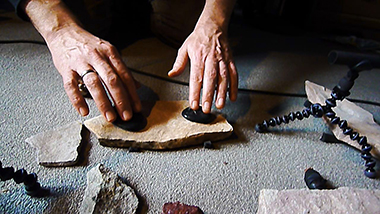Rhine Harp: a harpsichord wire is strung and tuned on a slightly bowed wooden stick. The flowing water causes the string to vibrate. This is made audible and recorded through a contact microphone placed on the stick.
Winter
Snowdrops: snow falls from trees on the banks of the Rhine into the water. Temperature differences and wind generate a rhythmic and melodic interplay.
Snow Monochord: a approx. six-meter long harpsichord wire is strung between two trees. Snowflakes, catching on the wire as they fall, create a rhythmic vibration. The sound is made audible through two contact microphones.
Snow Harp: harpsichord strings are tensioned and tuned on a wooden frame. Snowflakes hit the strings causing them to resonate. This process is recorded through a contact microphone on the stick.
Winter by the River: the quiet murmur and rushing sound of various streams on their wintery way to the Rhine.























